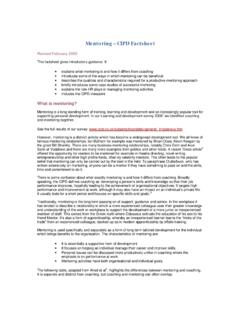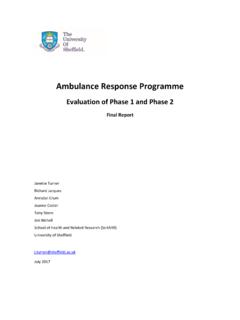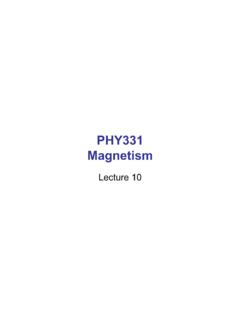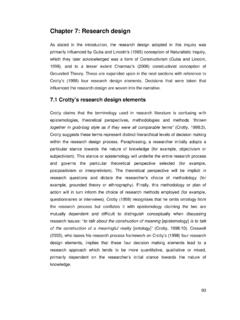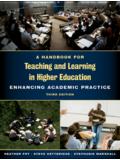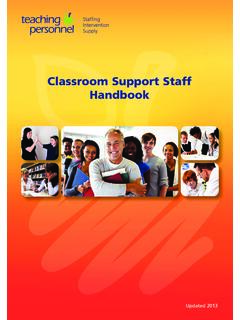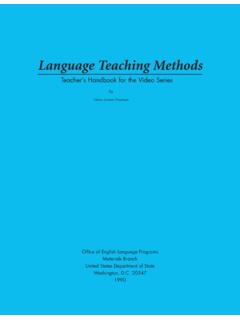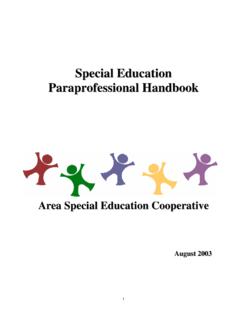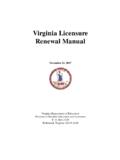Transcription of The inclusive learning and teaching handbook
1 IThe inclusive learning and teaching handbookby Elena Rodriguez-Falcon Marie Evans Claire Allam John Barrett Dave Forrest1 PageAcknowledgements ..2 Background ..31. Why you should read this handbook : Introduction ..52. Hints and tips for inclusive learning and teaching ..7a) Simple steps for effective interaction with ) Producing accessible handouts ..11c) Introducing critical thinking to students ..13d) Understanding individual needs ..15e) Presentations that work ..16f) Assessment matters ..18g) The inclusive classroom ..21h) Language in lectures ..22i) Engaging lectures ..24j) Making online materials more accessible ..26k) Planning your teaching .
2 28l) Exploring diversity issues ..30m) Hints and tips: Getting started ..31 Page3. Case studies ..32a) learning with people from the community ..34b) Enhancing inclusive polices and practice ..36c) Developing inclusive practice guides ..38d) Introducing learning and thinking styles ..40e) Closing the feedback loop ..42f) Involving students: Creating a sense of belonging ..44g) Developing a sense of community ..46h) inclusive student representation ..48i) Use of digital audio in learning ..50j) Welcoming diversity ..52k) Supporting the transition into university life ..54l) Case studies: Planning ahead ..564. Student engagement and partnership.
3 575. Bringing about change: Key factors ..616. Afterword: And so, what now? ..657. Further reading ..67 ContentsThe inclusive learning and teaching handbookBy Elena Rodriguez-Falcon, Marie Evans, Claire Allam, John Barrett, Dave ForrestIllustrations by Chris GlynnPublished by the inclusive learning and teaching Project, University of SheffieldCopyright The University of Sheffield 2010 ISBN: 978-0-9567228-0-5 inclusive learning and teaching ProjectLearning and teaching Services205 Brook HillSheffieldS3 7HG23 This handbook bears testament to the expertise, support and dedication of a range of colleagues and students from across the University who pursue the attainment of a truly inclusive learning and teaching could not have been achieved without them and we wish to express our gratitude to.
4 Claire AllamGary AlbuttRyan ArmitageKathryn AxonJohn BarrettAndrea BathSimon BeecroftGareth BraidTom BramallHenry BrunskillApril DawsonSue DavisonAlex ErdlenburghAngharad EvansMarie EvansKevin FarnsworthChris FirthDavid ForrestDeborah FowlerAngela GascoyneJames GoldingayJackie GreshamAlison GriffinKatherine HarrellJennifer HastingsAli HaywardTim HerrickChris InceSajeev JeganathanGlynis JonesBob JohnstonPlato KapranosRichard KelwickTerry LambMark LimbJames LittleAngela MarronGraham McElearneyDanny MonaghanMichelle MooreDavid MowbrayMarika PanayiotouAnne PeatAlan PhillipsDavid PhillipsAdrian PowellTom RhodesElena Rodriguez-FalconAnthony RossiterJenny RowsonEmily SavageCarolyn ShelbournSharah ShreeveJane SpoonerPatsy StarkBrendan StoneJuliet StoreyAnna SymingtonHolly TaylorKatrin ThomsonRebecca WatsonDarren WebbPaul WhiteWendy WhitehouseLouise Woodcockthinkers.
5 Moreover, the active participation of students in their learning helps build a sense of identity and community that further empowers inclusive learning and teaching handbook will help you to get involved. We hope you will find it both useful and inspiring, a resource that can be dipped into rather than read from front to back. The inclusive learning and teaching (ILT) Project was launched in 2007 as one of the strategic learning and teaching priorities of the University of distinctive approach of the Project was its scope, which was not limited to working with specific groups of students, such as disabled students, but which had a vision of: A University of Sheffield learning culture which enables all our students from whatever background to achieve their full potential.
6 During the life of the project over 500 students were consulted; over 400 staff engaged in debates and conversations; over 1500 academic staff and teachers received hints and tips for inclusive practice from students and 11 academic departments ran specific ILT handbook is the culmination of this work. Many people, staff and students, took part and we would like to share some of what we have learned with you. The enthusiasm and positive engagement of students has informed and directed much of our activity, it has also demonstrated that raising our awareness of inclusive learning and teaching and making changes to our practice can help students make the best of their time at university and support them in becoming independent learners and critical.
7 And all the other students and staff who, by sharing their experience, influenced and supported this you should read this handbook : IntroductionAt a time when the world faces one of the most severe financial challenges ever, climate change threatens mankind in different ways, and lack of resources begin to affect our life styles, we turn for solutions to our governments, research organisations and education institutions. But are these organisations ready to take on the challenges? Are we able to keep up with the pace at which these challenges are occurring? Do we have the capabilities to generate solutions, produce capable and adaptable professionals to deal with these threats?
8 In higher education institutions we have the academic capabilities to develop ideas and generate solutions through our research. Researchers and scientists battle with the problems of this era on a day-to-day basis, seeking innovative applications of current and emerging technology, discovering new treatments for illnesses, finding alternative methods to generate energy, or even establishing new approaches for wealth generation and job creation. All of this, however, requires a sound intellectual education that challenges convention and promotes innovation and creativity. All of this needs people to undertake the challenges people from different backgrounds, ideals, beliefs, abilities and ways of thinking.
9 It requires an inclusive learning , teaching and research attitude and culture to enable students, staff and stakeholders to develop their full potential and ultimately contribute to the challenges of this inclusive within this context also requires understanding, preparedness and resources to enable us to deal with an increasingly diverse set of student backgrounds, ability and attainment and larger classes whilst endeavouring to provide an excellent learning experience. All done at a time when public expenditure means resources are to be spread more thinly! So what to do?This handbook aims to address this issue by providing its reader with some ideas and examples of practical steps that easily can be taken to minimise the barriers to learning and increase participation of our students in their education.
10 First, however, we need to understand what we mean by inclusive learning and teaching as it can be a somewhat nebulous concept. Working within education, teaching and learning are familiar terms. On its own inclusion is easily understood. When you combine them together and create the concept of inclusive learning and teaching it is much harder to define. This is because there is no single definition, its meaning is dependent on the specific nature of a situation practice which includes one person/student may exclude another. The only constant is its purpose: that all are able to achieve. This is a bold aspiration but the material in this handbook also highlights the key factors, identified by the University of Sheffield s inclusive learning and teaching Project, which ensure that all students are able to achieve and contribute to a future that is happy and secure, both for themselves and for future generations.

